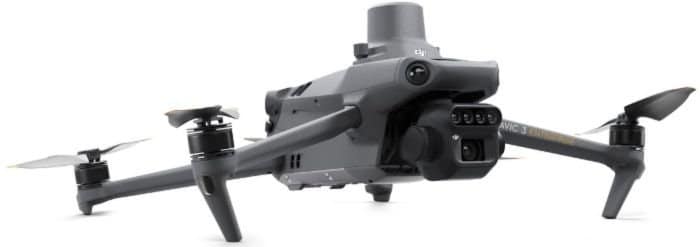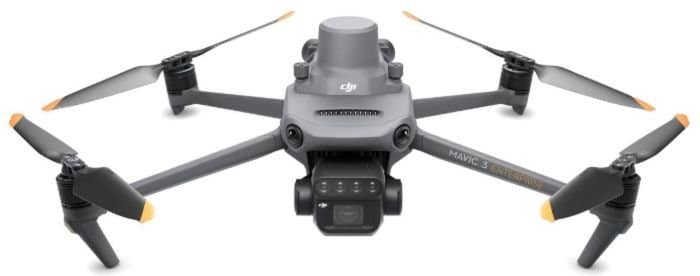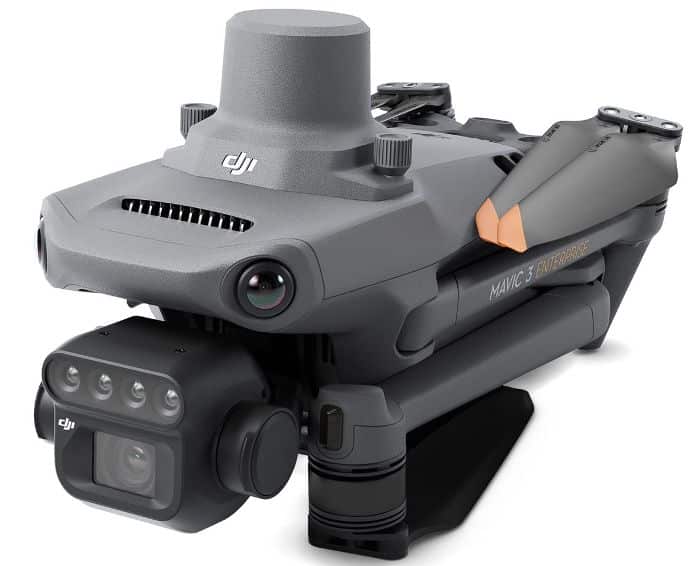DJI Mavic 3 Multispectral Review Summary

The Mavic 3 Multispectral drone is a small but powerful device designed for high-precision agricultural and environmental monitoring tasks. This foldable drone comes with a multispectral and an RGB camera that provides detailed imaging for comprehensive crop growth studies and various environmental observations. With its capability to survey up to 200 hectares per flight, the Mavic 3M enables swift and broad data collection. It stands out with its centimetre-level RTK positioning and microsecond-level time synchronisation, providing precise geographical information for each image. A notable feature is its long battery life of 43 minutes and the omnidirectional obstacle avoidance system, ensuring safe and prolonged aerial operations.
Key Features
Combines an RGB camera and a multispectral camera for comprehensive crop analysis. The multispectral camera captures data in green, red, red edge, and near-infrared spectral bands.
- RGB camera features a 20 MP 4/3 CMOS sensor with a mechanical shutter
- An omnidirectional obstacle avoidance system for safe and stable flight
- Centimeter-level RTK positioning with microsecond-level time synchronisation, efficient aerial surveying capability covering up to 200 hectares per flight
- Ultra-long battery life of up to 43 minutes with fast charging
- Supports O3+ transmission technology with two transmitting signals and four receiving signals for smooth image transmission of 15km.
- Applications include orchard mapping, variable rate applications, intelligent field scouting, and environmental monitoring Integration with DJI Terra or DJI SmartFarm Platform for high-resolution mapping, vegetation index analysis, and prescription map generation.
In this article, we shall take an in-depth look at one of the newest agricultural drones from DJI: the DJI Mavic 3 Multispectral. Designed for precision agriculture and environmental monitoring, this powerful yet compact drone is the successor to the DJI Phantom 4 Multispectral. The Mavic 3 Multispectral has improved features, including its dual camera system, improved flight time and transmission range. In this DJI
Mavic 3 Multispectral review, we shall explore all the features this drone comes with, its application, user experience and performance in real-world scenarios.
We’ll dive deep into the nitty-gritty of its high-performance dual camera system, designed to deliver high-resolution, multispectral imagery for even the most demanding applications.
We’ll then glide over the impressive enhancements made to flight time and transmission range.
In this review, we’ll also examine the Mavic 3 Multispectral’s diverse applications. Notably, its ability to capture detailed, data-rich imagery makes it an ideal tool not only for advanced farming techniques but also for in-depth environmental monitoring.
Whether you’re mapping invasive species, measuring vegetation health, or simply optimising your crop yields, the Mavic 3 Multispectral is poised to be a vital tool in your arsenal.
DJI Mavic 3 Multispectral Review – Design

The design of the DJI Mavic 3 Multispectral drone is aimed at providing advanced productivity tools for precision agriculture. It is compact and portable, weighing just 951 grams, allowing easy transportation and operation in various locations. The drone features a two-in-one camera system consisting of an RGB camera and a four-lens multispectral camera.
There is an RTK (Real-Time Kinematic) module on top that provides highly accurate positioning down to the centimetre level.
The DJI Mavic 3 Multispectral drone also has a special sensor that measures sunlight. This sensor helps the drone adjust its camera settings based on the sun’s brightness at any given moment. This ensures that the colours and details in the images it captures are as true to life as possible.
The drone has a multispectral camera comprising four 5MP sensors capturing G/R/RE/NIR (Green/Red/Red Edge/Near-Infrared) data. This allows for detailed analysis of crop growth and monitoring.
In addition to the multispectral camera, the Mavic 3 Multispectral also features an RGB camera with a 20 MP 4/3 CMOS sensor and a mechanical shutter. This camera provides high-resolution imaging capabilities.
The drone incorporates omnidirectional obstacle avoidance, utilising multiple wide-FOV (Field of View) vision sensors to detect obstacles in all directions. This ensures safe and stable flight, even in complex environments.
The Mavic 3 Multispectral boasts an ultra-long battery life of up to 43 minutes, allowing for extended flight time. It also supports fast charging with a 100W Battery Charging Hub, ensuring efficient and reliable operations.
The drone’s O3 transmission system integrates two transmitting signals and four receiving signals, enabling smooth and stable image transmission over ultra-long distances of up to 15km.
These design features of the DJI Mavic 3 Multispectral contribute to its versatility, reliability, and efficiency in various agricultural and surveying applications.
Remote Controller
The DJI Mavic 3 Multispectral drone pairs seamlessly with the DJI RC Pro, a professional-grade remote controller designed for high-level commercial use. This controller boasts many impressive features, including a next-generation processor, O3+ video transmission technology, and 4G network communication, ensuring optimal performance and stability for your drone operations.
A standout feature of the DJI RC Pro when used with the Mavic 3 The multispectral drone is its ability to display both RGB and multispectral data side by side in real-time on its high-brightness 5.5-inch 1080p screen. This clear and direct sunlight-readable display allows users to immediately analyse and make decisions based on the data collected.
The RC Pro controller’s enhanced processor and increased storage capacity also enable seamless integration with third-party applications like Pix4Dfields and DroneDeploy.
Alternatively, users can use DJI’s SmartFarm App or DJI Terra, depending on their specific needs and preferences.
The DJI RC Pro also supports videos played at 4K/120fps and provides a range of connectivity options, including a mini-HDMI port, USB Type-C port, and microSD card slot.
These features allow for versatile charging options, ample storage, and high-quality video output. The controller’s compatibility with Wi-Fi 6 protocol also ensures high-speed downloads for efficient workflow.
In summary, the DJI RC Pro controller is a powerful tool that significantly enhances the capabilities of the DJI Mavic 3 Multispectral drone, providing users with real-time, high-quality data analysis, precise control, and versatile application options.
DJI Mavic 3 Multispectral Review – Camera Quality

The DJI Mavic 3 Multispectral drone has a highly innovative camera system designed to optimise agricultural operations and facilitate informed decision-making for farmers and
agronomists. This dual-camera setup comprises an RGB (Red, Green, Blue) camera and a multispectral camera, each serving a unique purpose in the realm of agricultural analysis.
The RGB camera is designed with a high-resolution 20-megapixel sensor, capturing crystal-clear images of your fields. This isn’t just your average camera; it’s engineered with a 4/3CMOS sensor and a mechanical shutter to ensure a high-quality image with reduced motion blur.
This translates into more detailed, accurate visualisations of your crops, allowing for effective monitoring of overall crop health, growth and identification of potential issues such as pest infestations or nutrient deficiencies.
However, the real game-changer is the Mavic 3’s multispectral camera. This powerhouse features four different 5-megapixel sensors, each dedicated to capturing specific spectral bands: green, red, red edge, and near-infrared. By capturing images in these spectral bands, the multispectral camera can visualise information beyond the human eye’s reach. This data is crucial for understanding the intricate nuances of crop health on a deeper, more scientific level. The multispectral camera essentially allows the drone to “see” and analyse crop growth in a way that human eyes cannot.
It can pick up on subtle changes in crop colour and reflectivity that signal shifts in plant health, such as water stress, disease, or nutrient imbalances. This gives farmers, and agronomists access to precise, timely data that can inform critical decisions around irrigation, fertilisation, pest control, and harvest timing.
Together, the RGB and multispectral cameras on the Mavic 3 Multispectral are a powerful tool for precision agriculture. They deliver detailed, comprehensive insights into crop health and growth patterns, helping farmers and agronomists to optimise their operations, increase yields, and reduce waste.
In short, the DJI Mavic 3 Multispectral drone’s dual-camera system is more than just a high-tech gadget—it’s a transformative tool for modern agriculture, offering a clear window into the unseen world of crop health and providing vital data to drive smarter, more sustainable farming practices.
DJI Mavic 3 Multispectral – Use Cases
Drones equipped with multispectral cameras have a variety of applications in various sectors, particularly in agriculture, environmental monitoring, and research. Below are some of the key use cases:
Precision Agriculture
In modern farming practices, the use of multispectral drones have become increasingly popular due to their ability to provide detailed information about crop health at different stages of growth. By capturing images across multiple spectral bands, these drones can create detailed vegetation index maps, like the NDVI or EVI.
These maps give a visual representation of crop health by highlighting areas of stress long before they become visible to the naked eye. This early detection capability allows farmers to react quickly to problems such as disease or pest infestations, potentially saving entire crops.
Furthermore, the data from multispectral drones can be used to optimise irrigation and fertiliser application, as it provides insights into the moisture content and nutrient status of the soil. In this way, farmers can apply water or fertilisers precisely where needed, reducing waste and improving crop yield.
Undoubtedly, drones offer a plethora of advantages in the field of agriculture, with those equipped with multispectral cameras standing out as the premier choice.
The video below shows how to use the DJI Mavic 3 Multispectral drone for mapping fields with Pix4Dfields.
Related: Best Drones for Agriculture
Environmental Monitoring
Drones equipped with multispectral cameras have proven to be invaluable tools for tracking environmental changes over time. This could involve monitoring the health of a forest, tracking the spread of desertification, or assessing the recovery of an area after a natural disaster.
As environmental changes often occur gradually, regular monitoring with multispectral drones allows for the early detection of issues, enabling timely intervention. For instance, changes in vegetation health could indicate the onset of a disease, allowing for quick action to prevent its spread.
Forestry
Multispectral drones can be a game changer in forestry management. They offer a rapid and cost-effective method to monitor large forest areas, providing essential data about tree health, growth, and species distribution.
This data can be used to detect early signs of disease or pest infestations, assess the impact of environmental factors such as drought or fire, and plan targeted interventions. For instance, multispectral images can show changes in the chlorophyll content of leaves, an early indicator of tree stress.
Land Management and Conservation
For land managers and conservationists, multispectral drones offer a powerful tool to monitor land conditions, detect changes, and plan management actions. They can be used to map and monitor wetlands, a critical habitat for many species and an important component of the water cycle. The drones can provide regular, up-to-date maps of the wetland’s extent, vegetation cover, and water levels.
Similarly, they can help in detecting and tracking the spread of invasive species, allowing for targeted control efforts. In conservation areas, multispectral drones can be used to assess biodiversity by distinguishing between different types of vegetation and identifying specific habitat features. This detailed knowledge about the land and its vegetation cover can inform the design of conservation strategies, grazing management plans, or restoration projects.
DJI Mavic 3 Multispectral vs DJI Phantom 4 Multispectral
The Mavic 3 Multispectral is the successor to the Phantom 4 Multispectral; both are exceptional drones for agriculture. However, the Mavic 3 Multispectral comes with superior features.
The Phantom 4 Multispectral is another powerful tool for precision agriculture. Like the Mavic 3 Multispectral, it includes an RGB sensor and a multispectral sensor. However, the Phantom 4 Multispectral has six sensors: an RGB sensor and five monochrome sensors covering the blue, green, red, and red edge and near-infrared bands.
While the Phantom 4 Multispectral’s flight time is slightly less than the Mavic 3 Multispectral’s, at around 30 minutes, it still offers a robust solution for agricultural and environmental management needs.
Both the Mavic 3 Multispectral and Phantom 4 Multispectral drones are powerful tools for precision agriculture, capable of capturing detailed multispectral data.
The choice between the two will largely depend on your specific needs. The Mavic 3 Multispectral’s camera has better specs, longer flight time, obstacle avoidance technology, and portability may make it a better choice for larger operations or those in difficult-to-reach locations. On the other hand, the Phantom 4 Multispectral’s additional blue band sensor might offer more comprehensive data for certain applications.
DJI Mavic 3 Multispectral Price & Availability
The price of the DJI Mavic 3 Multispectral Drone will vary depending on which authorised retailer you purchase from and what the package includes. However, the price for the drone and DJI RC Pro controller is around $4500.
DJI commercial drones can only be purchased from DJI Authorised Resellers; you can find a list of all the companies that are authorised to sell DJI products here.
- Adorama (USA)
- DroneNerds
- Drones Direct (UK)
- Coptrz (UK)
Final Thoughts
In conclusion, the DJI Mavic 3 Multispectral is a high-tech drone designed primarily for agricultural and environmental use. It features a highly integrated imaging system that includes a 20MP RGB camera and four 5MP multispectral cameras. The drone is capable of precise aerial surveying and can cover up to 200 hectares per flight. It also includes features such as a sunlight sensor for more accurate NDVI results, an RTK module for centimetre-level positioning, and an omnidirectional obstacle avoidance system.

